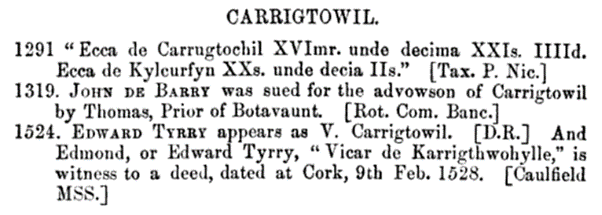Religious of the Parish
Carrigtwohill's Parish Origins
Kilcurfin & Templecurraheen
The ancient ruins of Kilcurfin church, more commonly known today as Templecurraheen are still
visible. Yet, its origins are perplexing to say the least, with its name possibly
being derived from the ancient Irish of Cill Coraichín for "Church of the Little Swamp".
Similarly, Templecurraheen, could be derived from Teampallcurrachin meaning ‘church of
the small bog’, or ‘church on a small patch of boggy land’. Both definitions being almost
alike.
In-fee is defined as of an estate in land, inherited or owned by one who has the absolute right
to dispose it as they desire, including the right to select an inheritor of the land. Although
there is no surviving evidence to support the theory that Kilcurfin was granted to Philip de
Barry circa 1183-1185, it is conceivably very plausible. Its intervening history when these lands
eventually formed a fee of Carrigtohill Manor is unclear, before finally being fully absorbed
into the Parish St David, many years later, with Kilcurfin falling into ruins.
Rev Brady’s next record is not for another two hundred years, 1524, with Edward (Edmond) Tyrry
as Catholic Vicar for the parish of ‘Carrigtowil’. Although Henry VIII had been a devout Catholic
in his younger years, and had defended the Pope against Martin Luther Protestantism, in 1534,
Henry declared that he, not the Pope, was the head of the Church in England.
 Clerical & Parochial Records of Cork, Cloyne, and Ross, by Rev William Maziere Brady, D. D
Clerical & Parochial Records of Cork, Cloyne, and Ross, by Rev William Maziere Brady, D. D
In Charles Smith’s ‘The Antient and Present State of the County and City of Cork, Vol I, 1701, he
advises us that Kilcurfin, was a particle belongs to the Prebend (portion of revenues of a cathedral
or collegiate church formerly granted to a canon or member of the chapter as his stipend) of Killenemer
(Killeenemer), a Townland between Fermoy and Mitchelstown, with Rectory Tithes belonging to Col. Carew.
More than one hundred years later Nicholas Carlisle, a Fellow and Secretary of the Society of Antiquaries
of London, published his ‘Topographical Directory of Ireland’ in 1810, within which it is stated
'Carrigtohill a village' was:
“valued in the King’s Book at £2, sterling, and united by Act of Council, from the most distant time, to
the particle of Kilcurfin.”
He goes on to declare there was no Glebe House, but the Glebe of nine acres was near the old church of
Kilcurfin.
In the ‘Miscellaneous Papers: Ireland, 21 April – 23 November 1820’, ordered by the House of Commons,
and published, 26th May 1820, reporting on the state of the so-called Establish Church created
by the Act of Union, 1800, that in ‘Carrigtohill’ there was a Church in repair, but there was no Glebe
House, ‘but one is going to be built immediately, on a glebe of 12 acres, lately purchased. It continues
there was ‘A small glebe at Kilcurfin,’ and that ‘The Curate’s salary was 50l., who resided ‘in the
adjoining parish.’
For the 1840s Valuation map shows that the Kilcurfin Glebe contained a little over 9 acres, and the Glebe
itself just under one acre.
Carrigtwohill or Charruig Thuaithil